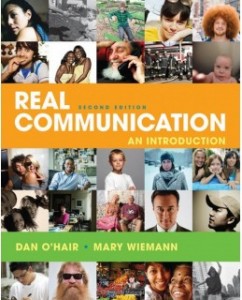Test Bank for Real Communication: An Introduction, 2nd Edition: Dan O’Hair
$35.00 Original price was: $35.00.$26.50Current price is: $26.50.
Test Bank for Real Communication: An Introduction, 2nd Edition: Dan O’Hair
Test Bank for Real Communication: An Introduction, 2nd Edition: Dan O’Hair

Product details:
- ISBN-10 : 0312644205
- ISBN-13 : 978-0312644208
- Author: Dan O’ Hair
Real Communication uses stories from real people and the world around us to present the best and most lively introduction to communication concepts. Professors and students alike have fallen in love with Real Communication’s down-to-earth writing style, its coverage of research, and its wealth of learning and teaching tools. They also appreciate how Real Communication strives to weave the discipline’s different strands together with the CONNECT feature that shows students how concepts work and apply across interpersonal, small group, and public speaking contexts. The Second Edition is even better with a broader array of engaging examples, new coverage of hot topics in the field like Intercultural and mediated communication, plus a public speaking unit honed to provide the essential information students need for this fast-paced course. Whether you want a traditional paperback, an e-Book — online or downloadable to a device — a looseleaf edition, or the book within the new HumanCommClass, Real Communication has an option for you. Read the preface.
Table contents:
Part One. Basic Communication Processes
Chapter 1. Communication: Essential Human Behavior
We Must Communicate: Functions Essential to Living
Expressing Affiliation
Managing Relationships
Influencing Others
How We Communicate
Communication Is Symbolic
Real Communicatior: Real communicator — what job will you hold?
Communication Requires a Shared Code
Communication Is Linked to Culture
Communication Can Be Unintentional
Communication Occurs through Various Channels
Communication Is Transactional
Assessing Communicative Value
Communicating Competently
Competent Communication is Process-Oriented
Competent Communication is Appropriate and Effective
Competent Communication Involves Ethical Decisions
Competent Communication Involves Communication Skills
Competent Communication Involves Using Technology
Wireless Communications: Email Etiquette: How Not to Communicate with Your Professor
Modeling Communications
The Linear Model
The Interaction Model
The Competent Communication Model
Evaluating Communication Ethics: Friends Who Have More or Less than You
The Study of Communication
Communication Across Cultures: The Boko Haram Girls
REAL REFERENCE: A Study Tool
Chapter 2. Communicating in a Digital Age
Digital Origins
Then and Now
Ongoing Dynamic Changes
Qualities of Digital Channels
Evaluating Communication Ethics: The Distracted Notetaker
Synchronicity of Messages
Media Richness and Naturalness
Message Privacy and Control
Communication Across Cultures: Mobile Apps Compete for World Influence
Message Privacy and Control
The Power of the Crowd
Information Sharing
Social Support
Social Causes
Real Communicator: Heather Wight
Overcoming Digital Challenges
Digital Disparities
Feeding Insecurities and Obsessions
Wired for Communication: Who I Am: Selfies as Visual Conversation, Self-Promotion and Identity
Cyber Attacks
REAL REFERENCE: A Study Tool
Chapter 3. Perceiving the Self and Others
Perception: Making Sense of Your World
Schemas: Organizing Perceptions
Attributions: Interpreting Your Perceptions
The Cultural Context
Communication Across Cultures: Sports Culture and Women’s Soccer
Improving Your Perceptions
Cognitions About Ourselves
Self-Concept: Who You Think You Are
Self-Esteem: How You Feel About Yourself
Self-Efficiacy: Assesing Your Own Abilities
Evaluating Communication Ethics: Ethics and the Self-Concept
Assessing Our Perceptions of Self
Real Communicator: Lisa M. Turay, CSJ
Behavior: Managing Our Identities
Self-Presentation
Self-Disclosure
Managing Feedback
Technology: Managing the Self and Perceptions
Wired for Communication: Avatars: An Idealized Self-Image
REAL REFERENCE: A Study Tool
Chapter 4. Verbal Communication
The Nature of Language
Language Is Symbolic
Thought Informs Language
Language Is Ruled by Grammar
The Functions of Language
Using Language as a Means of Control
Using Language to Share Information
Using Language to Express Feelings
Using Language to Express Creativity
Using Language as Ritual
Language and Meaning
Words Have Multiple Meanings
Abstraction
Problematic Uses of Language
Hateful and Hurtful Language
Labeling
Biased Language
Profanity and Civility
Evaluating Communication Ethics: Job Application Language
Language is Bound by Context
Situational Context
Relational Context
Communication Across Cultures: Racist Hats and Drums?
Cultural Context
Wired for Communication: Speaking in Code
Real Communicator: Scott Carper
Mediated Contexts
REAL REFERENCE: A Study Tool
Chapter 5. Nonverbal Communication
The Nature of Nonverbal Communication
Nonverbal Behavior Is Communicative
Nonverbal Communication Can be Intentional and Unintentional
Nonverbal Communication Is Ambiguous
People Trust Nonverbal Communication More Than Verbal Communication
Functions of Nonverbal Communication
Reinforcing Verbal Messages
Substituting for Verbal Messages
Contradicting Verbal Messages
Managing Impressions and Regulating Interactions
Creating Immediacy
Deceiving Others
Nonverbal Communication Codes
Gestures and Body Movements
Real Communicator: Octavia Spencer
Facial Expressions
Eye Behavior
Voice
Physical Appearance
Evaluating Communication Ethics: The Job Killer Tat
Touch
Space and Environment
Time
Influences on Nonverbal Communication
Culture and Nonverbal Communication
Communication Across Cultures: What Nurses Wear
Mediated Nonverbal Communication
Wireless Communication: War Games Without Weapons, Sometimes Without Words
The Situational Context
REAL REFERENCE: A Study Tool
People also search:
Real Communication: An Introduction
Real Communication: An Introduction Dan O’Hair
Real Communication: An Introduction Dan O’Hair 2nd
Real Communication: An Introduction Dan O’Hair 2nd Test Bank
Test Bank for Real Communication: An Introduction, 2nd Edition: Dan O’Hair Download
Related products
Test Bank
Test Bank for Essentials of Business Law and the Legal Environment, 11th Edition: Richard A. Mann











